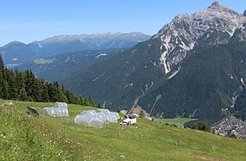Management of mountain meadows influences resilience to climate extremes
The species-rich mountain meadows of the Alps are subject to continuous land use changes and increasingly frequent climatic extremes. Persistent periods of drought are seen as the greatest threat to grassland ecosystems. To find out how a change in management influences the drought reaction of mountain meadows, a research team from the Max Planck Institute for Biogeochemistry in Jena together with international cooperation partners carried out field experiments in the Tyrolean Stubai Valley. The results of the study, currently published in the Journal of Ecology, show that land use controls the resistance and recovery capacity of mountain meadows through various interactions between plants and soil microorganisms.

Interaction of plants and soil microorganisms is important
Plants increase the activity of bacteria and fungi by passing on a part of their carbon from photosynthesis to them. This in turn leads to a greater release of plant nutrients in the soil and in addition, mycorrhiza fungi provide access to extra resources outside the roots. Longer periods of drought as predicted for the Alps, however, greatly reduce carbon uptake and input into the soil. Above ground, a withering of leaves and stems becomes visible, subterranean losses in nutrient uptake by the roots occur. However, a good supply of nutrients is important to ensure a quick recovery of the plants after the end of the drought.
Moderate management leads to faster recovery
The interdisciplinary team of scientists from Germany, France, Italy, and Austria investigated the carbon dioxide uptake and distribution in a total of 24 test plots at an altitude of over 1,800 meters using stable isotope labelling. During and after the drought, the researchers were able to follow the path of the carbon through plant sugars in leaves and roots up to root respiration and including absorption into various bacteria and fungi. In addition, they determined the strength of the plant's nitrogen uptake from the soil after drought.
The scientists were able to show that although the spare plant community of a fallow meadow reacts less strongly to drought stress; it recovers more slowly than the more productive plant community of a moderately cultivated hayfield. The higher resistance of the fallow land was accompanied by a greater spread of mycorrhiza fungi, which, with their hyphae network, improve plant access to water and nutrients in the soil. The hay meadow plants had a different strategy during the drought. They retained as many resources as possible in the form of sugars in their roots, but at the same time lost a lot of leaf mass. After the drought, these resources were released and the plants recovered quickly. The process was accompanied by an increased carbon transfer to free-living soil bacteria and fungi which are able to release further nutrients from the organic soil substance. On the basis of an increased nitrogen uptake during the recovery phase, the scientists were able to show that hay meadow plants can effectively absorb newly released nutrients in the soil and use them for regrowth.
Meadow ecosystems' ability to resist and to recover behave the other way round
Stefan Karlowsky, first author of the study and doctoral student at the Max Planck Institute for Biogeochemistry, explains: “A high level of resistance is followed by a slow recovery, while a lower resistance is accompanied by a rapid recovery.” Consequently, the effects of extreme droughts on mountain pastures can be specifically regulated and potentially mitigated through appropriate management. “To this end, we still have to find out how different periods of time and intensity as well as repeated droughts affect meadow ecosystems”, Stefan Karlowsky looks ahead. "We assume that the good recreational ability of the managed mountain meadows pays off during stronger or more frequent dry periods.” adds Prof. Gerd Gleixner. Through regular mowing, the plants are accustomed to storing more resources in the roots and to use them for rapid regrowth.
The research work was carried out as part of the BMBF project REGARDS (http://www.project-regards.org/).
